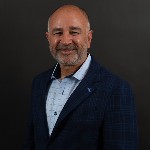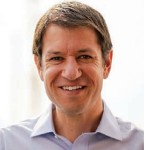- Interview with John Nooney, Mark Pickering and Charlie Perer of SG Credit Partners
- Secured Finance Foundation Establishes Scholarship and Diversity Committee and Launches Guest Lecture Program
- Ally and Affinity Groups: Helping to Bring Our True Selves to Work
- In the Spotlight: Women-Dominated Teams in Secured Finance
- Taking a More Proactive Approach to Retention
An Interview with Bobby Bans, Managing Director of Western Region Originations at Wells Fargo Capital Finance (WFCF)
March 12, 2024
By Charlie Perer

In this installment of our series of executive interviews, Charlie Perer sits with Bobby Bans to hear his views about his new role at Wells Fargo Capital Finance, the future of ABL, executive development and competition, among other things.
Charlie Perer: Thank you for your time, Bobby. To begin, can you please talk briefly about your background?
Bobby Bans: Thanks so much Charlie. I really appreciate the opportunity to talk with you and connect with the SFNet’s readers.
I have spent most of my career in commercial lending. I started at Bank of New York in credit, and then I moved to Fleet Capital as an analyst and quickly becoming an Underwriter working on cash flow and asset-based lending (ABL) deals. From there, I took a business development role with GMAC Structured Finance where I focused on cash-flow lending, covering private equity.
In 2006, I did something crazy and left banking to run my own automotive distribution business for three years, where I learned how difficult the life of an entrepreneur can be. After three years of working 24/7, I sold the business and joined Bank of America (BofA) with some of my former Fleet Capital colleagues. Since then, I’ve been in various roles in the commercial banking and ABL space, including portfolio officer, relationship manager, and business development officer. I’m currently a business development manager at Wells Fargo Capital Finance. I’ve had the privilege of working for and with great people who have taught me so much over my career.
Perer: You recently joined WFCF. What attracted you about the opportunity and why now?
Bans: I met Cyndi Giles and Dorothy Killeen, who are leaders within Wells Fargo Commercial Banking, and I learned about the group’s capabilities, depth of products and plans to grow the business. At Wells Fargo, I feel like I’m working within an entrepreneurial culture, but with a tremendous support system that encourages collaboration. I’m gaining a wealth of knowledge through everyone I meet.
I’m in a group that has some of the best industry specialists who have been a part of the ABL business for decades, so the value and knowledge they bring truly sets us apart.
Perer: What have you been focused on since joining the group?
Bans: It’s been six months since I joined Wells Fargo. The first few months I spent a lot of time listening to what’s working well and what needs work. I established leadership within my regions and have been working to bring my industry knowledge of the ABL landscape in the west to my team. I’ve focused on getting to know our Strategic Capital group, which manages our merchant banking activities, as well as our Investment Banking teams to find creative solutions for our clients. Our main focus has been to ensure that we are properly supporting our Commercial Banking colleagues when they have new opportunities, such as when we have a client that potentially should move from cash flow to ABL.
Perer: What are you doing to create differentiation and is it more product or approach driven?
Bans: It’s definitely both. You need to have the products and capabilities, which I believe we have at Wells Fargo, and which was the primary reason I wanted to join the company. Armed with a great product set, we must then go to market as one bank and demonstrate that we can deliver whatever our clients need.
Perer: What’s the relationship between WFCF and the Commercial Bank?
Bans: WFCF is a key business within Wells Fargo Commercial Banking, and we are all working towards the same goal of delivering for our clients. While we are well-aligned across the business, we are constantly looking for ways to do better. The leaders within our various business groups stay very closely connected with monthly meetings where we discuss prospects and share market updates. Approximately 50% of our business comes from within other areas of the Commercial Bank, it’s very important for my team and I to stay well connected.
Perer: Please talk about the senior leadership of WFCF?
Bans: The senior leadership at Wells Fargo Capital Finance is what initially drew my interest to the bank – we have smart, driven leaders who wholeheartedly believe in their teams while encouraging individuals to learn and grow. It’s an environment where we are able to leverage each other’s strengths, work together to deliver for clients, and ask for help when needed. This is one area where I have been really pleased and I can see now why people never leave.
Perer: How helpful has it been to be able to draw on the best of both worlds now having seen how two large bank-ABL shops are run?
Bans: It’s a huge benefit! I’m able to compare and contrast the various processes, credit appetite and structures. No institution is perfect, but what’s important is that your institution is working to make improvements and is flexible. Since arriving at Wells Fargo, I have had numerous conversations with various leaders who are focused on improving efficiency and the customer experience, so that’s been very encouraging.
Perer: What are banks doing now in order to retain/attract talent when so many direct lenders/private credit funds are poaching talent from the bank training pools?
Bans: This seems like it’s a concern for many companies. Some of our colleagues have gone on to join private equity and private credit companies. I see that as a huge compliment that these teammates were in high demand, and Wells Fargo played a part in preparing them for their new roles. Having said that, retaining our top talent is essential by making sure we are creating opportunities for our junior talent by defining career paths, expanding skill sets, and creating an environment that people want to stay in. As a leadership team, we are continually discussing how to keep everyone engaged and demonstrate that we support them.
Perer: Why have you chosen to stay in the banking world when you’ve likely had compelling opportunities to join a private credit/alternative lending strategy?
Bans: I enjoy working for a large bank that has a great brand. While there are folks who feel the regulatory environment within the large banks can be challenging, I feel that for the type of risk we take, it’s necessary and we have learned to work within the parameters. Also, I enjoy working with and having a huge support system that may not exist at a private credit fund.
Perer: We’ve heard since coming out of Covid that there would be a lot of internal corporate cash flow/leverage deals to borrowing base/ABL structures, but it doesn’t seem to have materialized as anticipated. Do you envision that might change in 2024?
Bans: Ha! That has been talked about for years, even before Covid. I’ve stopped making predictions on what will happen and focus more on controlling the controllables. Having said that, companies are experiencing some signs of stress and that can be seen in their portfolios. If large bank ABLs are seeing this in the portfolio, I believe that commercial and corporate banking clients are seeing similar challenges. Everything I read states that credit markets are seeing some dark clouds, spurred by high interest rates and cost of debt. If rates remain at this level for a prolonged period, we would expect to see an increased migration of cash flow transactions to ABL.
Perer: Are you able to talk about the recently announced relationship with Centerbridge Partners and this new direct lending capability?
Bans: Yes! We’ve entered into a strategic relationship with Centerbridge Partners, who have launched Overland Advantage to focus on direct lending to middle-market companies. Overland creates better access to private credit for family-owned and closely held businesses, historically, private credit has focused on financial sponsor transactions. It gives our middle-market clients another choice when financing their most strategic transactions, such as an acquisition or buy-out. The feedback from clients and the market has been terrific, and our bankers are excited to deepen our already strong client relationships with this additional option.
Perer: SaaS lending is housed under your group. Can you talk about the legacy of that group and what makes it such a strong market leader?
Bans: At Wells Fargo, we have a long (20+ year) history lending to sponsor-backed software companies where we were an innovator for this kind of lending on a bank platform and laid the path for many other banks to follow. Given our history, we have an experienced team with a deep subject-matter expertise and lending experience through all cycles from hundreds of platform financings. Beyond sponsor-owned businesses, we have a broad reach within the non-sponsor software community through our commercial and corporate banking relationships. Today, we have a flexible financing solution, from traditional cash flow, to ARR, to unitranche and, geographically, we’re comfortable lending internationally, as we have a team based in London that we worked very closely with.
Perer: How would you characterize the current state of ABL market?
Bans: I think everyone in the industry has been seeing somewhat slow volume. I believe this is a reflection of i) higher rates, ii) the fact that most clients upsized or amended facilities during 2021 when inventory needs increased (commodities) or they were impacted by supply chain issues, and iii) low M&A volume which reflected instability (rates, EBITDA declining, inflation). We are also seeing incumbents leaning in to retain customers instead of being heavy handed.
We have seen more activity in the last month or two as market participants feel like there is more stability, with inflation more stable and rates declining. 2024 will be interesting!
Perer: How has the bank-ABL BDO job evolved over the past ten years and how will it evolve over the next 10 years?
Bans: The knowledge requirement for the ABL BDO/origination officer has increased significantly in the past 10 years. Aside from having a very experienced credit mind and confidently knowing what your institution can deliver, you need to understand and be able to speak intelligently about bank products such as treasury, cash flow lending, swaps, and many other products. While you are not expected to be an expert because we have them for each of our products, you want the customer to feel that you are knowledgeable of various financial solutions that could support their business.
Perer: How will this next economic cycle test the relationship between commercial banks and their ABL groups?
Bans: It really depends on how connected the groups are and, more importantly, the credit appetite of the ABL group. At Wells Fargo, we are part of the Commercial Bank so we have shared leadership to ensure we are all on the same page and best supporting each client.
Perer: Lastly, tell us something you are worried about that the rest of the market has yet to figure out.
Bans: The things that worry me, I’m sure worry many people. Over the past few years, there has been so much uncertainty that you must consistently plan and prepare and be ready to adjust at a moment’s notice. It’s easy to be consumed by the things you can’t control. My philosophy is to always stay focused on what you can control and turn that worry into energy that can make a positive impact. Maybe it’s the optimist in me, but I’m more excited about 2024 and beyond than I am worried!

